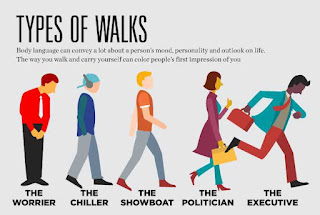Walking style we should know.
Walking style is a subtle yet revealing aspect of human behavior, reflecting personality, mood, and physical condition. Observing someone's gait can provide insights into their confidence, energy levels, and emotional state. A confident stride often involves upright posture, with shoulders back and head held high, conveying self-assurance and purpose. Conversely, a hesitant or shuffling gait might indicate uncertainty or discomfort.
Additionally, the pace of one's walk can convey a sense of urgency or relaxation. A brisk, purposeful stride suggests focus and determination, while a leisurely saunter implies a more relaxed attitude. Furthermore, variations in arm swing, stride length, and foot placement contribute to the uniqueness of each individual's walking style.
Factors such as age, culture, and physical condition influence walking style. Older individuals may exhibit a slower, more cautious gait due to age-related changes in balance and mobility. Cultural norms also play a role, with some societies placing emphasis on maintaining a dignified, reserved demeanor while walking, while others may encourage more expressive movements.
Furthermore, physical conditions such as injury or illness can impact walking style. Someone with a sprained ankle may limp or favor one side, while a person with a neurological disorder might exhibit an unsteady or irregular gait.
Psychologists and researchers have long studied the connection between walking style and personality traits. For example, studies have suggested that individuals with a confident, assertive personality tend to have a more purposeful and upright gait, while those who are more introverted or anxious may exhibit a more hesitant or self-conscious walking style.
Moreover, changes in walking style can be indicative of underlying health issues. For instance, a sudden change in gait pattern, such as dragging one foot or leaning to one side, may signal neurological problems or musculoskeletal issues that require medical attention.
In recent years, technology has enabled more sophisticated analysis of walking style through tools such as gait analysis systems and wearable sensors. These technologies allow researchers and healthcare professionals to assess gait patterns with greater precision, aiding in the diagnosis and treatment of various conditions affecting mobility.
Understanding and appreciating the nuances of walking style can have practical applications in fields such as healthcare, sports science, and even law enforcement. For instance, healthcare professionals may use gait analysis to assess rehabilitation progress or detect early signs of conditions such as Parkinson's disease. In sports science, analyzing an athlete's gait can provide valuable insights into biomechanical efficiency and injury prevention. Law enforcement agencies may also use gait analysis techniques for forensic purposes, aiding in the identification of individuals captured on surveillance footage.
Overall, walking style is a multifaceted phenomenon that encompasses physical, psychological, and cultural dimensions. From conveying personality traits to signaling health conditions, the way we walk offers a rich source of information about who we are and how we move through the world.




Comments
Post a Comment